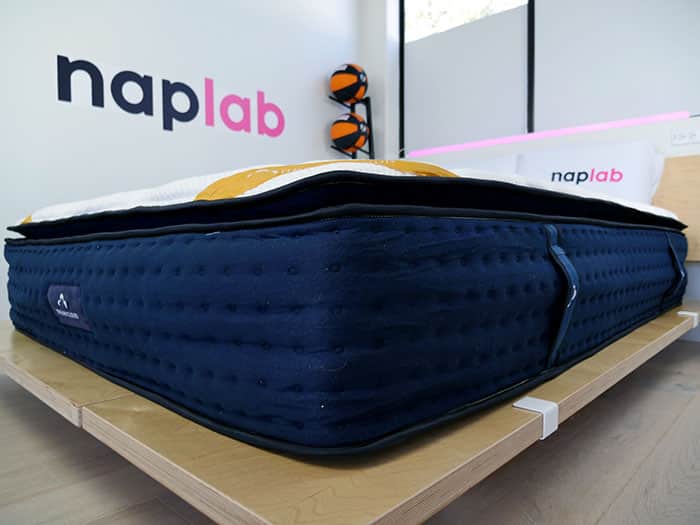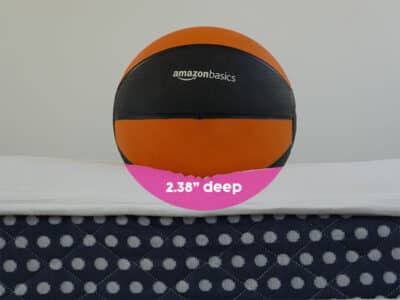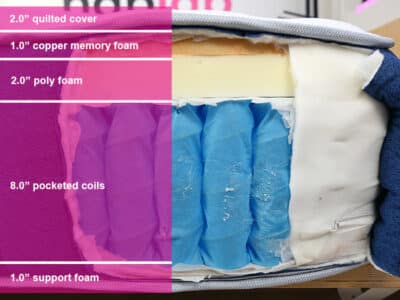Plush mattresses come in a range of types and sold with a range of different (often consuming) names.

Features like a quilted cover, euro top, pillowtop, knit cover, as well as firmness of the comfort layers and level of support from coils or support foam can all contribute to the plushness of a mattress.
Best For
- Lightweight sleepers who still want hug and contour
- Cloud-like softness
- Limited motion transfer
Considerations
- May not be supportive enough for back or stomach sleepers
- Also may not work for heavier sleepers
In This Guide
What is a Plush Mattress? | Best Plush Mattresses | Plush vs. Firm | Firmness vs. Support | Who Should Use A Plush Mattress | Is a Plush Mattress Right For Me? | FAQ
What is a plush mattress?
A plush mattress offers luxurious softness, while maintaining support, contour, and fantastic pressure relief.
Plush mattresses are oftentimes good choices for lightweight sleepers because they require less weight to engage the contour and hug that the mattress provides.

Best Plush Mattresses
The table below highlights the highest scoring plush mattresses we’ve tested to date. The average overall score we see (across all mattress types and firmnesses) is 8.64.
All of the plush mattresses below perform better than average.
| Mattress | Type | Score | Read Review | Check Price |
|---|---|---|---|---|
| Saatva Classic | Coil-on-Coil | 9.95 | Read Review | Check Price |
| Diamond Flurry Lux | Hybrid | 9.84 | Read Review | Check Price |
| Nolah Evolution 15 | Hybrid | 9.77 | Read Review | Check Price |
| Winkbeds | Hybrid | 9.74 | Read Review | Check Price |
| Bear Elite Hybrid | Hybrid | 9.72 | Read Review | Check Price |
Plush vs. Firm
Plush and firm are at the opposite end of the spectrum when it comes to feel. A plush mattress is very soft, having more sinkage and contour.
On the contrary, a firm mattress has less sinkage and therefore sleepers may not always engage directly with the deeper support layers.

A plush mattress cannot be firm. And a firm mattress cannot be plush.
Firmness is a direct result of:
- Plushness of the materials
- Material density
There are some features that may enhance a plush mattress including a pillow top, Euro cover, or a tufted quilted cover.
When these features are used on a firm mattress the feel may be slightly softer on top, but you’re still not going to get the same level of contour or hug as you would on a soft, plush mattress.
What is a pillowtop?
A plush mattress with a pillowtop has plush top layers, but there is a gap between the pillowtop and the rest of the mattress.
This can be a small gusset or another aesthetic break in the materials on the side of the mattress.

Pillowtop mattresses have a deeper hug and sometimes have poorer edge support just because of the softness of the top layers.
What is a Euro cover?
A Euro cover, also known as euro top and euro style pillowtop, has similar materials as the plush pillowtop cover, but it is functionally and aesthetically different.
With a Euro cover, the plush top layers are sewn flush with the edge of the mattress instead of having a break.
This helps to reinforce the edges and you may not sink into the materials as much as you would with a pillowtop.
As the name suggests, this style of cover originated in Europe, but remains a popular design approach across the world.
What is a quilted cover?
A quilted cover had plush layers including batting, foam, cotton, wool, and other textiles quilted into the top fabric so that it acts and performs as a single layer.
They are not typically as thick as a pillowtop or Euro cover, but do add some softness to the overall feel of the mattress.

Quilted covers can be tufted or non-tufted, but it’s the quilting of multiple layers that gives it a plush feel.
Firmness vs. Support
Let me say this loudly right out of the gate. Firmness does not equal support.
A firm mattress can lack support. And by the same token, a plush mattress can have a soft feel, but still be very supportive.
Support is a result of material type, material density, and sleeper weight.
The side-by-side comparison below shows me lying on the Diamond Flurry Lux. This is the exact same mattress in both images.
On the left, I am 140 lbs. On the right, I have added a 60 lb. vest to take my total weight up to 200 lbs.


You can easily see the difference in sinkage and support as the contour line of my body takes a completely different shape with extra weight.
How soft is a plush mattress?
I would say that the typical firmness for a plush mattress is around 3.0 – 4.5 out of 10, where 10 is the most firm.

Anything softer than this tends to be SO soft that it lacks support. When you sink too deeply into a mattress, your spine can easily get out of alignment and cause uncomfortable pressure points.
Winkbed Soft (4 / 10)

Winkbed Original (6 / 10)

The mattress on the left is plush (aka “Softer” version) and the mattress on the right is medium firmness (ala “Luxury Firm” version).
Click here to read the full review of these two mattresses.
You can see how much deeper the ball engages with the foam layers on the softer mattress.
Who Should Use a Plush Mattress?
A plush mattress may not be for you, but there are a lot of sleepers who benefit from this kind of mattress.

Plush mattresses are typically good choices for:
- Side Sleepers: When sleeping on your side, body pressure is targeted to one side. To avoid pain and get a good night’s rest, it helps to contour the body
- Lightweight Sleepers: Lightweight sleepers can engage more deeply with a plush mattress. But because their body isn’t too heavy, they’re not sinking all the way through to the support layers.
- Sleepers with Joint Pain: Joint paint is commonly found in the hips and shoulder and these two areas can generate a lot of pressure. On a plush mattress, these parts of the body are cradled and supported, which relieves pressure points.

Plush mattresses may not be right for:
- Stomach Sleepers: Stomach sleepers usually need a firmer mattress to keep their spine in alignment. While plush mattresses can be comfortable initially, over an extended period of time stomach sleepers will likely find that it lacks the support they need to stay pain-free.
- Heavyweight Sleepers: Heavier sleepers are another category that might not be right for a plush mattress. The amount of support a 150 lb. sleeper needs on any mattress compared to a 300 lb. sleeper is not the same.
If you’re a heavier sleeper or a stomach sleeper, but you still want to give a plush mattress a try, consider a plush hybrid. Hybrids usually have better support for heavier sleepers compared to an all-foam mattress.
For instance, check out the two plush mattresses below—plush hybrid vs. plush memory foam.
Plush Hybrid vs. Plush Memory Foam
Both of these mattresses have a similar firmness. Both would also be considered plush mattresses. They each have 5″ of comfort material and an 8″ support system.
But check out what happens when each mattress has a 200 lbs. weighted sleeper on the mattress.
The support on the Bear Elite hybrid is much better than the Ashley Sleep Gruve in this instance. It has a sharper contour and better edge support for the heavier sleeper, even though both mattresses have a similar firmness.
The table below highlights what sleeping position and body weight may be best for different plush mattress types.
| Mattress Type | Best Position | Best Body Weight |
|---|---|---|
| Plush coil & spring | Side or Back Sleepers | Moderate to Heavy |
| Plush hybrid | Side or Back Sleepers | All |
| Plush memory foam | Side Sleepers | Lightweight to Moderate |
| Plush latex foam | Back or Stomach Sleepers | Lightweight to Moderate |
Is a Plush Mattress Right for Me?
Whether or not a plush mattress works for you depends on a few factors:
- Body Weight
- Sleeping Position
- Personal Preference
#1. Body Weight
When heavier sleepers lie on a plush mattress, chances are that they won’t be able to receive the type of support they need. As I mentioned above, plush mattresses allow for more contour with minimal weight.

So when more weight is applied the result is excess sinkage, possible pressure relief issues, and possible support issues as well.
In most cases, I would not recommend a plush mattress for any sleeper over 250 lbs.
#2. Sleeping Position
Sleeping position is another big factor to consider here. Generally, side sleepers prefer a softer feel than back or stomach sleepers, completely independent of body weight.

When you lay on your side, your midsection and hips sink deeper into the mattress than the rest of your body. Because of this, different areas have different support needs.

Some plush mattresses may offer zoned support systems to help compensate for this. But not all do.
#3. Personal Preference
The last factor is the wild card—personal preference. While the guidelines I included above are true in most cases, there are always exceptions.
Consider the type of feel that you find to be the most comfortable. Do you like to sink into the mattress? Do you like it to hug you? Do you like to feel like you’re sleeping in a cloud?
If you answered yes to any of these questions, a plush mattress may be right for you.
FAQ
A plush mattress is generally between 3-4.5 out of 10 on the firmness scale.
The lifespan of a plush mattress depends more on its type than its firmness. Generally, plush foam mattresses can be expected to last 10-15 years.
A plush spring mattress lasts 7-10 years. And a plush hybrid would be somewhere in the middle—10-12 years. Plush latex can last 10-15 years. All that being said, the exact lifespan of any mattress depends on who is sleeping on it, foundational support, mattress quality, and other environmental factors.
Not always. The level of support provided by a mattress depends on a mix of firmness, material composition, material density, and sleeper weight. Just because the feel is soft, does not mean that a plush mattress will not provide support.
A pillowtop has a plush top layer that is visually separate from the rest of the mattress—like a pillow sitting on top.
A Euro cover (aka euro top, aka euro style pillowtop) has the plush top layers sewn together, within the layers of the rest of the mattress. There is no visual separation.
A quilted cover adds to the plush feel by quilting together soft layers like organic cotton or wool. A basic quilted cover is generally thinner than a pillowtop or Euro-style cover.








